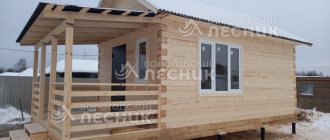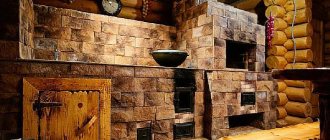Modern bathhouse with autonomous water supply
For bath procedures to bring real pleasure, it needs to be properly equipped. And first of all, make sure that the water supply system in the bathhouse is reliable and works all year round, including the coldest months.
However, not everyone needs this. For many people, the bathhouse is located at their summer cottage, and there is simply no point in investing in a complex system. Therefore, here we will consider all possible water supply schemes for a bath, from the simplest to the most functional.
Water supply diagram
One of the issues that must be resolved is how to supply water to the bathhouse so that it does not freeze in winter. There are three main options for water supply:
- Artesian well . An ideal solution for winter water supply to a bathhouse. The only negative is the excessive cost. In addition, wells can often become clogged with sand, so they will need to be additionally equipped with powerful filter systems.
- Well . This option is suitable for those citizens whose plots have their own wells. Arranging the water supply will not be difficult, but in order to prevent water pollution, you will have to equip the well and pipes with filters.
- Centralized water supply . The simplest option. To connect the bathhouse to the water supply, you will need to prepare a plan with detailed calculations and obtain permission.
Let's look in more detail at how to get water into the bathhouse so it doesn't freeze in winter - what features the water supply schemes have.
Well
If there is a well with a constant flow of water at your summer cottage, it will not be difficult to install a water supply system for a bathhouse.
Scheme of supplying water to the bathhouse from a well Source mycdn.me
If there is no source of water, you can dig a well yourself. To do this, you need to take measurements to determine the source of groundwater.
Once water is discovered, drilling needs to be done, after which you can begin digging a hole for the subsequent construction of a well. You will need to purchase rings equipped with a special fastening system that will allow them to connect to each other, preventing soil and sand from getting into the water.
To prevent the structure from shifting, it is necessary to tighten the rings with metal staples. In places where the rings come into contact, special gaskets made of flax or jute are installed (rubber is allowed). This will filter the water and prevent contaminants from entering the liquid.
Sealing water pipes Source germo.ru
Since the well is a system for collecting underground water, a filter must be installed at the bottom of the structure. To do this, you will need to purchase geotextiles, stones and fine crushed stone. The space outside the well is filled with sand. This material will protect the walls of the structure from water and minimize the possibility of frost heaving. When arranging a well, you need to pay attention to the insulation of the structure. The best option is to use polystyrene foam.
Water is collected through pipes. To bring water into the bathhouse, special attention must be paid to waterproofing and sealing. Experts recommend following these rules:
- Bituminous mastic cannot be used as a sealant. When using it, the water becomes cloudy.
- To create a waterproofing layer, silicone and a special tile adhesive, which is highly frost- and water-resistant, are laid.
- After the silicone has dried, it is necessary to apply several layers of fiber rubber and liquid glass.
- Clay, foam plastic and loam are laid.
- The final stage is the arrangement of a water supply system and the installation of a pump.
Waterproofing of water supply pipes Source kolodec-rem.ru
To prevent water from freezing in winter, the outlet of the pipeline must be below the freezing depth of the soil.
Well
The depth of the well depends on the location of the fluid source. Water is supplied from a sand lens, or from an underground reservoir (artesian well).
In the first case, the depth of water extraction is 20-40 m. The life of the well is short, since the water reserves in the sand lens are insignificant. In summer, due to high temperatures, there is a possibility of the source drying out.
In the case of an artesian well, the water source is constant, without interruptions and the possibility of drying out. The depth of such a well can be from 40 to 200 m. Given the depth of the underground source, special permission will be required for construction.
Almost every person living in the private sector knows how to supply water to a bathhouse from a well. This will require additional equipment. We are talking about a container for storing water resources, a special pumping system with high power, and a filter for cleaning.
Water supply diagram from a well Source teplo.guru
Due to the significant depth of water, the possibility of it freezing at sub-zero temperatures is minimal. Especially if the system is equipped with a powerful pump. To prevent possible negative situations, the pipeline will need to be insulated to prevent the possibility of liquid freezing at low temperatures.
Central water supply
This is the simplest and fastest option for supplying water to the bathhouse. To avoid any difficulties, the bathhouse structure should be located close to communications.
To bring water into the bathhouse from home, you will need to obtain permission from regulatory authorities. Specialists will conduct a thorough analysis, study power parameters, the potential volume of required resources, and prepare an acceptable water supply project. If all recommendations are followed, no difficulties will arise, the user will receive permission to implement the water connection project.
Important! When connecting a bathhouse to a central water supply, the user will be required to install meters to monitor the use of water resources.
Diagram of water supply to the bathhouse from the central water supply Source ngsserv.ru
If the user wants to know how to install water supply to the bathhouse so that the water does not freeze in winter, the existing pressure in the system must be taken into account. If mistakes are made, the pressure in the water supply may become unstable or decrease noticeably. In view of this, the water supply system must be equipped with special equipment that does not affect the overall pressure in the system.
See also: Catalog of companies that specialize in design and installation of water supply and sewerage.
Pipes and pumps for winter water supply to baths
When supplying water to a bathhouse, the choice of suitable equipment, including pipes and pumping systems, is of great importance. Otherwise, during the cold season you may encounter serious problems, which will require completely changing communications.
Types of pumps for water supply Source stroyday.ru
There are three types of pumping systems, each with its own characteristics:
- Float pumps . They float on the surface, sitting on a special float. If the water in the well freezes in winter, then such a pump will not work. Therefore, it is most often used for watering the site during the warm season.
- Vibrating submersible pump . Most often used to supply water from a well. The equipment is characterized by a low price and acceptable quality of work. But at the same time, it is necessary to carefully calculate the parameters of the system, since otherwise it may not be enough to ensure regular water supply to the bathhouse.
- Deep submersible pump . The equipment is used for permanent use. The unit must operate stably; due to downtime, its quality indicators can seriously deteriorate. Often used when supplying water from wells with a depth of 20 m.
Installation of water supply pipes Source uralremont66.ru
Before running water into the bathhouse, you need to devote time to the issue of choosing pipes. Polypropylene products are ideal for water distribution. The material is easy to solder; pipes can be laid in hard-to-reach areas. As for laying pipes between the water source and the bathhouse structure, the use of polypropylene is permitted provided that the pipeline is insulated. Otherwise, after 15-20 winter cycles, cracks will form on the pipes, which will entail the need to repair communications.
When choosing pipes, you should adhere to the following recommendations:
- The products are made of material that can withstand both extremely low and high temperatures. This is especially true in cases where the water supply occurs through a central water supply system, and both cold and hot water enter the bathhouse.
- The pipe material must be plastic and have significant resistance to sudden changes in temperature conditions.
- Products must have a significant service life, be universal and not require additional maintenance.
Pipes for water supply Source litcult.ru
Selecting pipes will not be difficult. Previously, metal ones were used, but with the advent of new technologies, it is possible to use products made of plastic and polypropylene that meet all quality and safety standards.
Recommended types of pipes that can be used
It is very important to choose the right pipes.
They must meet the following requirements.
- Long service life .
Since the main part of the pipes must be laid below the freezing point of the soil, replacing them will be difficult and not economically profitable. - Ability to withstand large temperature changes.
- They should be easy to install and dismantle.
Until recently, only metal pipes were used. At the moment, the situation has changed.
For these purposes, products made of polypropylene and polyethylene are now used.
Installation of water supply in a bathhouse
Pipeline installation consists of a number of fundamental stages:
- Design. Initially, the user will have to make accurate calculations, calculate how many meters of pipes will be required, what additional equipment and fasteners will be used.
- Construction of the trench. The trench should be dug below the freezing point to prevent possible icing of the pipes during frosts. If the ground is rocky or clayey, it is recommended to fill the bottom of the trench with a cushion of sand.
Construction of a trench for a pipeline Source yandex.net
- Using special equipment, a hole is formed through which the water supply will be brought out. It is important here to reduce possible heat loss, therefore thermal insulation is laid between the pipe and the ground surface.
- Since most foundations are strip, the pipeline should be placed under the foundation of the bathhouse.
- A separate hole is dug in the ground to accommodate pumping equipment. To ensure uninterrupted operation of the unit, the niche should be insulated as much as possible.
- At the final stage, the pipeline is installed and pumping equipment is connected.
Design
Before laying pipes, it is necessary to carry out calculation procedures and decide on the connection diagram. In order to save time and money you will:
- calculate the amount of thermal insulation material;
- determine the length of pipes required for installation of the system;
- calculate the number and format of fasteners, connectors and fittings;
- determine the additional equipment required for connection.
Design is also necessary in order to obtain consent to carry out work from regulatory authorities.
Video description
This video clearly shows the features of installing a valve drain:
In areas with frosty winters (from -20 C), it is recommended to install a valve drain for water. The diagram is mandatory when supplying water to a bathhouse that does not have constant heating and is used seasonally. The procedure involves a strict sequence of actions:
- A trench is created under the main pipe using a garden auger. In this case, the depth of the trench is set at least 0.5 m below the freezing point.
- A plastic elbow in the shape of the Latin letter U is soldered into the pipe located above the well. A hole is drilled in the lower part of the product and a fitting is inserted.
- The lower part of the well is covered with sand. A hose is placed on the fitting, the end of which is covered with a protective geotextile cover. In this case, the lower part of the hose must have free access to the sand pad.
The creation of such a system will allow excess water to be drained into the ground. When the valve is closed, the remaining water will go into the ground through the drain elbow. Moreover, if the well is located outside and the water freezes, due to the drainage of excess moisture, the pipes will not burst.
Valve water drain Source ytimg.com
Important! When forming a valve drain, the depth of the water layer must be taken into account. If it is at a minimum distance from the surface, the indicated technique is not used. This is due to the high risk of groundwater pollution.
Insulation and pump connection
One of the most reliable ways to make water supply in a bathhouse so that it does not freeze in winter is to insulate the water supply outlet areas. Any thermal insulation material that can prevent heat loss will do. In addition, it is recommended to insulate the pipes directly, especially in regions with cold winters. You can do this using:
- Creating an insulated zone around the pipe. The easiest option is to use sand. It will not only create a barrier to prevent water from freezing in the pipes, but will also reduce the earth pressure on the pipeline.
- Laying the heating cable along the length of the pipeline. It operates from the electrical network, ensuring a uniform supply of heat.
Pumping equipment connection diagram Source septik.guru
Nuances of thermal insulation of a well
If the well is built using traditional technology and has a log frame, the water in it does not freeze even in the most severe frosts, since wood is an excellent natural heat insulator.
But concrete rings, which are being used more and more widely, conduct heat well, transferring cold from the frozen ground. Wells with a high water table are at particular risk of freezing.
To insulate a concrete well, you will have to dig out rings to the freezing depth for a given region (plus a small reserve in case of a particularly cold winter). Next, the rings are covered with narrow strips of penoplex so as to ensure maximum adherence to the concrete. The gaps between the sheets and rings and the joints are filled with polyurethane foam. Polystyrene foam is not suitable for this purpose; it will crumble when filled with soil. Mineral wool will inevitably become saturated with moisture and lose its heat-shielding properties.
The house above the well should also be insulated with polystyrene foam; this material is not afraid of moisture.
Ways to protect your water supply
In general, any method of supplying water to a bathhouse so that it does not freeze in winter requires the following set of actions:
- pipes are laid below the soil freezing level;
- complete dehydration of the pipeline after visiting the bathhouse;
- ensuring continuous movement of water in pipes;
- heating the pipeline with a special electric cable;
- insulation of pipelines installed above the freezing point.
Constant heating of pipes is characterized by excessive high cost. Ensuring continuous movement of water is permissible only if the bathhouse is constantly in use. Otherwise, this method is too expensive in terms of paying for utilities.
An example of insulation of water pipes in a bathhouse Source airikinsulation.com
If the bathhouse does not have constant heating, the most acceptable option would be to ensure water drainage in pipes, storage tanks and fittings. If there is no liquid left in all components of the system, there will be nothing to freeze.
In addition, a reliable way to protect the water supply in winter is to additionally insulate the pipes and locate key elements of the system below the freezing point. In any case, you need to follow the advice of experts on how to properly supply water to the bathhouse so that it does not freeze in winter.
Selecting a heating element
The choice of heating method depends on the available resources.
- Connection to the home system. If the bathhouse is located next to a residential building in which a heating system with liquid coolant is installed, then the issue of heating during the period between visits to the bathhouse is easily resolved. Thermally insulated supply and return pipes are led into the bathhouse and connected to the boiler. Radiators are installed in the bathhouse premises. If the floor level in the bathhouse is lower than in the house, you will have to install an additional circulation pump.
- Autonomous water heating. If the site is gasified, then in the bathhouse you can install a local water heating system with its own low-power boiler. This will reduce heat loss and heating costs.
- Solid fuel stove. Heating a bathhouse with a solid fuel stove is widespread. It is good for a steam room, but requires constant fuel supply. For a summer cottage visited once a week, this option is not suitable; you will have to spend money on an electric heater.
- Electric heaters. They do not allow the temperature of the sauna or bath to drop below 5°C.
Solid fuel stove in a bathhouse
The main selection criteria are the cost of operating the system for a season and the reliability of ensuring a positive temperature in the bathhouse premises.











